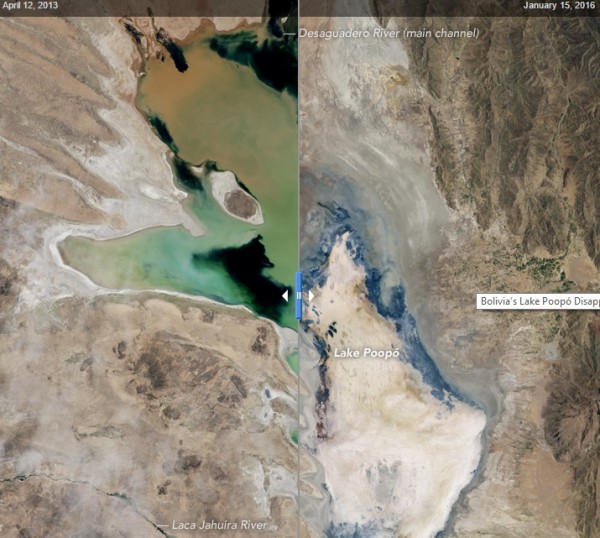By Ana Verayo, | January 25, 2016

Bolivia's second largest lake, Lake Poopó disappeared in just a matter of three years.
Lake Poopó, the second largest lake in Bolivia apparently mysteriously disappeared, where a vast, barren land was left behind. Experts believe that a number of factors contributed to this event, such as climate change, drought and expanding agriculture.
Like Us on Facebook
NASA images reveal the lake's changing appearance from 2013 to 2016 where these satellite photos taken by the Operational Land Imager show how the water disappeared in just a period of three years. Scientists believe that this can take longer to refill, where some experts also believe that the lake could now be forever lost.
NASA officials say the during a normal year, the rainy season spanning from December to March can replenish water supplies of the lake directly and also from other sources such as the Desaguadero River. However, almost a month into the rainy season, drought still continues.
Scientists reveal that this is not the first time that the entire lake evaporated, when the lake dried up last 1994. However, the lake apparently took seven years to recover and as the water returned, ecosystems also struggled to recover from these harsh conditions.
The lake hosts an important fishing resource for the communities nearby where this drought caused hundreds of people to lose their sources of living, alongside with a looming sense of recovery not returning to the lake. According to glaciologist, Dirk Hoffman, this event is the picture of climate change. This drought is apparently triggered by El Niño where it is now on its peak and whatever water is left from the lake is diverted to mining sites and agricultural communities.
Apart from extreme water level variations, smaller shifts in the amount of rainfall can also render a massive impact on the lake. Scientists say that Lake Poopó is located within the Altiplano basin of Bolivia where it is also connected upstream to Lake Titicaca and then downstream to the massive salt fields.
Now, these smaller changes in the amount of precipitation along with river inflows can also affect the lake surface area. Scientists say that when the lake level is less than one meter during the wet season, this will yield a shallow lake that can eventually dry out during the dry season.
Along with crucial data from ENSO (El Niño Southern Oscillation) forecasts, this combined information can help in obtaining a more accurate estimation of lake levels providing more lead time and taking immediate action to prevent disaster for the fishing population, due to the dangerously low levels of Lake Poopó.
This new study is published in the Hydrological Sciences Journal.
-
Use of Coronavirus Pandemic Drones Raises Privacy Concerns: Drones Spread Fear, Local Officials Say

-
Coronavirus Hampers The Delivery Of Lockheed Martin F-35 Stealth Fighters For 2020

-
Instagram Speeds Up Plans to Add Account Memorialization Feature Due to COVID-19 Deaths

-
NASA: Perseverance Plans to Bring 'Mars Rock' to Earth in 2031

-
600 Dead And 3,000 In The Hospital as Iranians Believed Drinking High-Concentrations of Alcohol Can Cure The Coronavirus

-
600 Dead And 3,000 In The Hospital as Iranians Believed Drinking High-Concentrations of Alcohol Can Cure The Coronavirus

-
COVID-19: Doctors, Nurses Use Virtual Reality to Learn New Skills in Treating Coronavirus Patients







